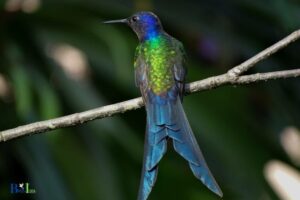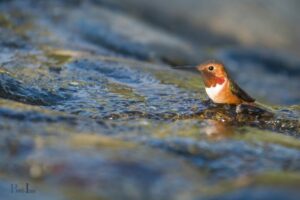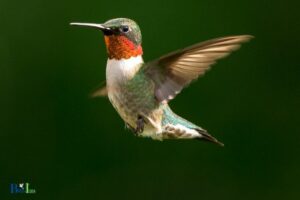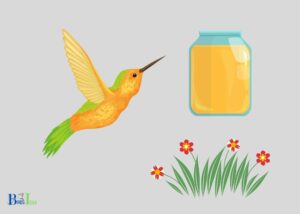When Do Hummingbirds Nest in Kentucky: April-July!
Hummingbirds typically nest in Kentucky from late April to early July.
The most common species of hummingbird in Kentucky is the Ruby-throated Hummingbird.
They migrate to Kentucky from their wintering grounds in Central America during the spring. Upon arrival, they immediately begin the process of courtship, mating, and nesting.
The nesting season lasts through early summer, after which the hummingbirds start preparing for their migration back to Central America.
During the nesting season, hummingbirds can be observed engaging in various behaviors, such as courtship displays, feeding on nectar, and catching insects.
The female hummingbird is responsible for building the nest, which is usually constructed on a small branch in a deciduous or mixed forest.
The nest is cup-shaped, made with lichen, moss, and spider silk to provide strength, camouflage, and insulation for the eggs and young hummingbirds.
Nests are typically very small, about the size of a golf ball, and are well-hidden to avoid predation.
3 Regions of Hummingbirds Nest in Kentucky
| Kentucky Region | Nesting Start | Nesting Peak | Nesting End |
| Western Kentucky | Late April | May – June | Late July |
| Central Kentucky | Early May | May – June | Early August |
| Eastern Kentucky | Mid-May | June – July | Mid-August |
Key Takeaway
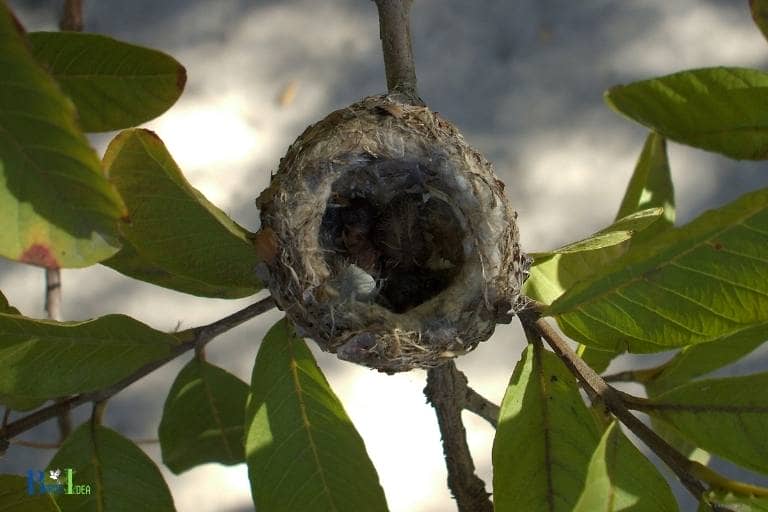
Five Facts About: Hummingbirds Nesting in Kentucky
Understanding The Hummingbird Life Cycle And Nesting Habits
Kentucky is home to some of the most beautiful bird species, including the hummingbird. Understanding the hummingbird life cycle and nesting habits can help bird enthusiasts spot these agile creatures and appreciate their unique characteristics.
Let’s get started!
Overview Of The Hummingbird’S Annual Life Cycle
Hummingbirds are known for their remarkable flying abilities, bright colors, and small size. They are found in many parts of north and south america, and kentucky is no exception.
These tiny birds follow an annual life cycle, which includes breeding, migration, and feeding.
Here are the key points to keep in mind:
- Breeding: Hummingbirds breed during the summer months, from may to july, in kentucky. The females build the nests, lay eggs, and raise their young ones. The males participate in the courtship dance and territorial battles.
- Migration: After the breeding season, hummingbirds begin their long journey south. They cross the gulf of mexico and fly through central america to reach their wintering grounds in mexico, central america, and south america.
- Feeding: Hummingbirds feed on nectar from flowers and insects along the way. They have a high metabolism and require constant food intake to maintain their energy levels.
Hummingbird Nesting Habits
Hummingbirds have unique nesting habits that set them apart from other bird species. Their nests are among the smallest and most intricate in the avian world.
Here are the key points to keep in mind:
- Nest location: Hummingbirds prefer to build their nests in sheltered locations, such as under a tree branch, on a wire, or in a shrub. They need protection from the wind and rain.
- Nest building: The female hummingbird builds the nest using twigs, spider webs, and other materials. She shapes the nest using her breast and lays two tiny eggs.
- Incubation: The female incubates the eggs for about 16 days, while the male guards the nest and feeds her.
- Fledging: After hatching, the chicks remain in the nest for about 18-22 days, depending on the species. The parents feed them a diet of insects and nectar until they are ready to fly.
Hummingbirds are fascinating creatures that navigate an annual life cycle full of challenges, risks, and rewards. Understanding their life cycle and nesting habits can help us appreciate their beauty and respect their habitat.
Next time you spot a hummingbird in kentucky, take a moment to observe its behaviors and admire its unique characteristics.
Happy birdwatching!
Identifying Hummingbird Species In Kentucky
When it comes to bird watching, hummingbirds are undoubtedly an exciting species to spot! In kentucky, the migration patterns of hummingbirds depend on the seasons.
If you’re curious about when hummingbirds nest in kentucky, stay with me, and i will guide you through identification and more!
Differentiating Between Hummingbird Species Found In Kentucky
Kentucky boasts two of the most common hummingbird species: the ruby-throated hummingbird and the rufous hummingbird.
Understanding the unique characteristics of these two species can make identification easier.
The Ruby-Throated Hummingbird
- Male ruby-throated hummingbirds have a metallic green back and a vibrant red throat.
- Females have a green back, white breast, and a light green throat.
- These birds are about 3 to 3.5 inches in length and weigh around 0.1 to 0.2 oz.
- They prefer gardens, meadows, and woodland edges with plenty of nectar-bearing flowers.
The Rufous Hummingbird
- Rufous hummingbirds are smaller than ruby-throated hummingbirds and have a rusty-colored back.
- Males have an iridescent orange-red throat, and females have a greenish back with spots of rust on the flanks.
- They weigh 2 to 5 grams and are 2.8 to 3.5 inches long.
- Rufous hummingbirds prefer open woodland areas and gardens rich in nectar.
Learning To Identify Hummingbirds By Sight And Sound
Identifying hummingbirds can be tricky, as their wings beat incredibly fast, and they move quickly from one flower to another.
Here are some tips to identify these tiny birds by sight and sound:
Sight
- Hummingbirds have the ability to fly backward, forward, up, down, and even hover in mid-air.
- Their quick wing movements, similar to that of insects, help them stay airborne.
- Look for iridescent feathers and unique body shapes to differentiate hummingbird species.
Sound
- Hummingbirds make a sharp, metallic sound with their wings that’s easy to identify.
- Ruby-throated hummingbirds produce a metallic “tzeet” sound, while rufous hummingbirds have a chirping “chit-chit” sound.
Identifying hummingbird species requires a keen eye for detail and expertise. By understanding the unique characteristics and habits of the birds that call kentucky home, we can spot these beautiful creatures with ease. Happy bird watching!
Timing Of Hummingbird Nesting In Kentucky
When Do Hummingbirds Nest In Kentucky?
Hummingbirds are fascinating creatures that can be seen in kentucky during the spring and summer months. If you’re wondering when these tiny birds nest, you’ve come to the right place.
In this section, we’ll discuss the timing of hummingbird nesting in kentucky and the factors that can influence it.
Seasonal Timing Of Hummingbird Nesting In Kentucky
Hummingbirds typically nest in kentucky from late may to early august. The exact timing can vary depending on the weather conditions and other environmental factors.
Typically, the availability of nectar from blooming flowers is a primary influence on the nesting schedule of kentucky hummingbirds.
When flowers are abundant and blooming, hummingbirds can nest earlier in the season. Conversely, if flowers are scarce, they may delay nesting until later in the summer.
During peak season, you should keep an eye on your hummingbird feeders to ensure they have ample nectar available to feed their young.
If you see that your feeder is empty, you should refill it as soon as possible to avoid stressing the birds.
Factors That Can Influence Nesting Timing
Several different factors can impact the timing of hummingbird nesting in kentucky.
Here are a few of the main ones:
- Weather conditions: Heavy rainfall or cool temperatures can delay nesting.
- Availability of food: As mentioned earlier, the availability of nectar is a key factor in determining a hummingbird’s nesting schedule.
- Daylight hours: The length of daylight has an impact on a hummingbird’s hormone production, which can influence nesting behavior.
- Migration patterns: Hummingbirds that migrate through kentucky may nest earlier or later than those that are resident year-round.
It’s important to remember that while these factors can influence nesting timing, hummingbirds are adaptable creatures that can adjust their behavior as needed.
Hummingbirds in kentucky typically nest from may to august, with the schedule influenced by nectar availability, weather conditions, and other environmental factors.
By understanding the seasonal timing and influences on hummingbird nesting, you can ensure that you provide the best possible habitat for these delightful birds.
Choosing The Best Nesting Sites For Hummingbirds In Kentucky
Habitat Requirements For Successful Hummingbird Nesting
Hummingbirds are magnificent birds with unique nesting requirements. They need specific habitats to build their nests and raise their young ones.
If you want to attract hummingbirds to nest in your yard, you need to ensure their habitat requirements are met.
These requirements are as follows:
- Sufficient light: Hummingbirds prefer nesting sites that receive a lot of sunlight. They are attracted to the warm and sunny locations that are shielded from the wind and rain.
- Protection: Hummingbirds seek quiet, sheltered locations for nesting. They prefer areas with overhead cover such as trees, shrubs, or even man-made structures like awnings and overhangs.
- Water source: Hummingbirds need access to clean water to drink and bathe. A water source such as a bird bath or fountain in the nest vicinity can provide a cooling and refreshing spot to attract hummingbirds.
Creating Ideal Nesting Sites Through Landscaping And Nest Boxes
Landscaping is one of the best ways to create ideal nesting sites for hummingbirds in kentucky.
Here are some tips for landscaping your yard to attract hummingbirds:
- Plant native flowering plants: Hummingbirds are attracted to plants that produce tubular flowers in red, orange, and pink hues. You can plant trumpet honeysuckle, bee balm, and cardinal flower to suit the hummingbird’s needs.
- Provide ample branches and cover: Hummingbirds require plenty of branches and cover to dart in and out of their nests. You can create clumps of trees, use shrubs, or even grow climbers against walls to create ample cover.
- Install nest boxes: You can install nest boxes in your yard to attract hummingbirds. The ideal nest box opening should be 1.5 inches in diameter, and it should be mounted on the lower branches of a tree or shrub, where it can be sheltered from rain and wind.
Overall, by following these tips, you can create an ideal nesting site for hummingbirds in your yard while protecting their natural habitat.
FAQ On When Do Hummingbirds Nest In Kentucky
When Do Hummingbirds Typically Nest In Kentucky?
How Do I Find A Hummingbird Nest?
How Can I Attract Hummingbirds To My Yard?
How Long Does It Take For Hummingbird Eggs To Hatch?
What Should I Do If I Find A Fallen Hummingbird Nestling?
Conclusion
As a resident of kentucky or a bird enthusiast visiting the state, you may be curious about when hummingbirds nest in kentucky. It’s essential to understand that these tiny creatures are highly migratory and can travel thousands of miles to return to their breeding grounds.
Thankfully, research and observation indicate that hummingbirds arrive in kentucky around late april to early may and begin nesting almost immediately.
Summer is the peak nesting season for these birds, and their breeding cycle lasts for about 27 days, with the female hummingbirds taking care of the eggs and young ones.
While kentucky is not the most popular state for hummingbird spotting, it is still a great location.
So, if you want to visit some prime hummingbird locations in kentucky, be sure to check out bernheim arboretum and research forest, the louisville nature center, and the salato wildlife center.
Get out and explore the beautiful bluegrass state, and don’t forget to keep your eyes peeled for these delightful little creatures.

